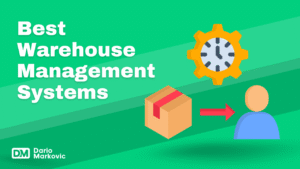Why does it matter whether I display estimated delivery date and time in Shopify store? Let’s try to answer this question.
“When will my order arrive?”
Believe it or not, this simple question could be costing you sales.
Customers expect certainty when they place an order. Without it, they hesitate or abandon their cart. Adding a simple delivery estimate is a great way to improve customer satisfaction, reduce abandonment carts, and increase conversion rates by up to 30%.
Several Shopify merchants consistently emphasize the importance of communicating delivery timelines to build customer trust.
So if you run a business on Shopify, offering delivery estimates is no longer optional.
In this guide, we’ll break down why and how display estimated delivery date and time in Shopify store matter and how you can easily set them up in your Shopify store.
Why Does it Matter to Display Estimated Delivery Date and Time in Shopify
- Builds customer trust: When a store provides accurate delivery estimates, it reassures buyers that their purchase will arrive on time. First-time shoppers, in particular, are more likely to complete their purchase when they see a clear delivery timeline. If two stores sell the same item, the one offering a specific delivery date has the advantage as customers value transparency and clarity.
- Improves purchase decisions: Clear timelines help customers make informed decisions.
For example, Aaron, VP of Demand Generation & Marketing at Thrive Internet Marketing Agency found that implementing geolocation-based delivery estimates increased conversions.
“By showing personalized delivery dates, customers, especially first-time buyers felt more confident completing their purchase.”
- Reduces support queries: 39% of Americans track their orders once a day and 19% track them multiple times each day. Clearly, fewer “Where’s my order?” inquiries to your customer service team reduce support queries related to order tracking.
- Increases conversion rates: A specific delivery timeframe reassures customers. In fact, 75.1% of shoppers indicated that putting an EDD on the product page or in the cart positively influences their decision to buy an item.
Methods to Add Estimated Delivery Dates in Shopify
There are three ways to add estimated delivery dates on Shopify.
1. Using Shopify’s Native Features (simple but limited)
If you’re just getting started, Shopify has some built-in tools you can tap into:
- Shipping profiles: You can set approximate shipping times for different zones. Customers see this info during checkout.
- Order tracking page: Once an order is placed, Shopify provides a timeline-style tracking page with fulfillment status.
Pro Insight: According to Shopify’s Help Center, combining shipping profiles with fulfillment locations helps provide more accurate delivery estimates, but you won’t be able to display dynamic ETAs on product pages natively.
2. Using Third-Party Apps
If you want to display personalized, dynamic ETAs on product pages, consider Shopify apps like:
- Estimated delivery date & time: Offers global and regional delivery estimates, 30+ templates, and cut-off time rules.
- Omega’s estimated shipping date provides advanced customization options, geolocation-based estimates, and multiple shipping rules.
3. Custom Code Integration
If you’ve got dev resources or love getting your hands dirty, you can custom-code delivery estimates using:
- Shopify Liquid (theme language)
- JavaScript + metafields
- Custom logic for cutoffs, fulfillment centers, etc.
Pro tip: Shopify’s Developer Docs recommends using cart attributes or line item properties to pull in custom ETA info dynamically.
Step-by-Step Guide to Displaying Delivery Estimates
Let’s go through the steps of displaying estimated delivery estimate to your product page.
Using a Shopify App
- Log into Shopify admin and visit the App Store.
- Search for an estimated delivery app and install it.
- Configure app settings, including:
- Regions or countries served.
- Delivery timelines for specific products or locations.
- How and where the estimate is displayed (e.g., product pages, cart).
Using Custom Code
- Back up your Shopify theme to avoid data loss.
- Access the theme editor in the Shopify admin.
- Edit product page templates to include a script for calculating and displaying delivery estimates.
- Add logic for weekends, holidays, and different shipping zones.
- Test thoroughly to ensure accurate display and functionality.
Best Practices for Showing Delivery Estimates
Jon Morgan has worked with several eCommerce businesses to optimize their Shopify stores for a better customer experience suggests:
- Use precise language like “Arrives by [date]” or “Estimated delivery: 3-5 days.” Avoid vague terms like “Ships soon.”
- Integrate real-time shipping data from carriers to provide accurate timelines, especially during peak seasons. Apps like “Order Delivery Date” or “Tracktor” can help.
- For items with varied shipping times (e.g., made-to-order goods), include product-specific estimates.
- Reiterate the delivery date during checkout to prevent surprises.
Jon Morgan, CEO & Editor-in-Chief at Venture Starter highlights a recurring issue:
“ Managing delays due to unexpected logistics disruptions is an ongoing issue. Always build a buffer in your estimates and communicate proactively if delays occur. Over-promising delivery times can harm trust, so it’s better to under-promise and over-deliver.”
| Also, consider these factors when displaying estimated delivery dates Inventory location & fulfillment centers Shipping carriers and service level agreements Geolocation/personalization capabilities Cutoff times for order processing Weekends and holidays Integration with Shopify apps or third-party tools Mobile responsiveness and UI/UX placement Handling pre-orders or out-of-stock scenarios Fallback logic if delivery estimates can’t be calculated |
Delivery Estimates: A Statistical Deep Dive
The Numbers That Matter
In online retail, delivery estimates drive business performance. Here’s the critical data.
Customer Expectations and Behavior
- 75.1% of online shoppers say estimated delivery dates influence purchasing decisions
- 39% of customers track orders daily
- 19% check order status multiple times daily
- Cart abandonment drops 10-15% with clear delivery estimates
Economic Impact
Conversion and Revenue
- Stores with delivery estimates see 30% increase in completed purchases
- Potential annual revenue lift: $75,000 – $250,000
- 82% of Shopify merchants report improved customer retention
Support Cost Reduction
- Customer support interaction cost: $8 – $12
- “Where’s my order?” inquiries reduced by 40%
- Annual support cost savings: $50,000 – $150,000
Regional Performance Variations
Conversion Lift by Region
- North America: 30% increase
- Europe: 25% improvement
- Asia-Pacific: 22% purchase confidence boost
Implementation Approaches
Cost and Complexity Breakdown
- Native Shopify Features
- Implementation time: 1-2 hours
- Cost: Free
- Suitable for: Small businesses
- Third-Party Apps
- Monthly cost: $10 – $50
- Implementation time: 2-4 hours
- Features: Advanced customization
- Custom Integration
- Development cost: $5,000 – $25,000
- Implementation time: 4-12 weeks
- Ideal for: Large enterprises
Customer Psychology
Trust and Transparency
- 97% of customers consider delivery estimates crucial
- First-time shoppers 40% more likely to complete purchase with clear delivery info
- 65% report increased confidence in stores with precise delivery estimates
Future Projections
Emerging Trends
- Machine learning delivery prediction accuracy to improve 35% in next 3 years
- Personalized delivery windows will become standard in 72% of e-commerce platforms
- Blockchain-verified shipping estimates gaining market traction
Competitive Landscape
Businesses with transparent delivery information:
- 2.4x more likely to retain customers
- 1.8x more likely to see year-over-year growth
Pricing Plans on the Shopify App Store
Shopify app store offers four pricing plans to display ETA on your products:
Basic plan
- $3.99/month or $39.99/year (Save 16%)
- 1,000 monthly ETA views
- Global ETA for all products
- 30+ creative ETA templates
- Set lead days, weekdays, and cut-off time
- Multilanguage support
- WhatsApp support
Growth plan
- $5.99/month or $59.99/year (Save 17%)
- 5,000 monthly ETA views
- Includes everything in Basic, plus:
- ETA rules for product, collection, inventory, country, tag, vendor, zip code, location, and shipping
- FOMO countdown timer
- WhatsApp support
Premium plan
- $8.99/month or $89.99/year (Save 17%)
- Unlimited ETA views
- Includes everything in Growth, plus:
- Exclusive animated ETA templates
- Intelligence analytic reports and insights
- Priority WhatsApp support
Special plan
- $59.99/month or $599.99/year (Save 17%)
- Features:
- Custom feature requests (up to 2 requests per month)
- Requests applicable based on discussion
- Dedicated support
Dario’s Takeaway
Whether you use Shopify’s native features, leverage third-party apps, or dive into custom coding, the key is to prioritize transparency and reliability in your delivery communications.
By proactively answering the age-old customer question, “When will my order arrive?”, you not only enhance the shopping experience but also build trust, reduce cart abandonment, and boost conversion rates.
Remember, eCommerce businesses that set clear expectations and consistently meet them are the ones who turn first-time buyers into loyal customers!
FAQ
Why are estimated delivery dates important for my Shopify store?
Estimated delivery dates are crucial because they:
- Build customer trust by providing transparency
- Help customers make informed purchase decisions
- Reduce cart abandonment rates
- Decrease customer support inquiries about order status
- Potentially increase conversion rates by up to 30%
Do customers really care if we display estimated delivery date and time in Shopify store?
Yes! Research shows that:
- 75.1% of shoppers say delivery estimates positively influence their buying decision
- 39% of customers track their orders daily
- First-time buyers are especially likely to complete a purchase when they see a clear delivery timeline
What are the main ways to display estimated delivery date and time in Shopify store? store?
There are three primary methods:
- Shopify’s Native Features (basic, built-in option)
- Third-Party Shopify Apps
- Custom Code Integration
Can I use Shopify’s built-in features to show delivery estimates?
Yes, you can use built-in features to display estimated delivery date and time in Shopify store, but with limitations:
- You can set approximate shipping times for different zones
- Customers can see shipping information during checkout
- The order tracking page provides a fulfillment status timeline
- However, you cannot display dynamic estimated delivery dates on product pages natively
What should I look for in a third-party delivery estimate app?
Look for apps that offer:
- Global and regional delivery estimates
- Multiple template options
- Cut-off time rules
- Geolocation-based estimates
- Advanced customization options
Do I need technical skills to display estimated delivery date and time in Shopify store?
It depends on your chosen method:
- Native Shopify features require minimal technical skills
- Third-party apps are typically plug-and-play
- Custom code integration requires development resources and knowledge of Shopify Liquid, JavaScript, and metafields




